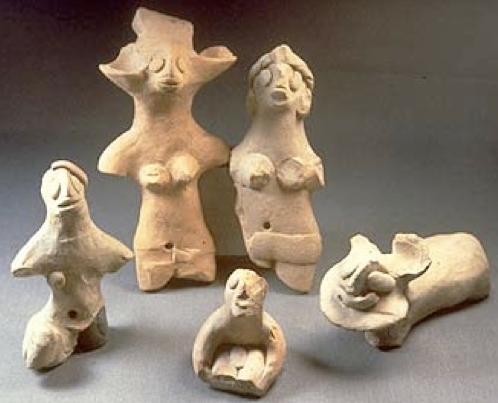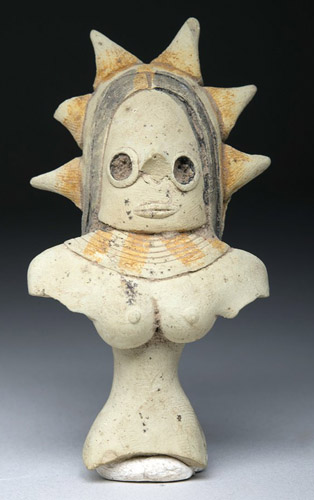A Glimpse at the Human Figurines of the Indus Valley
Civilization - Jithin R. Veer
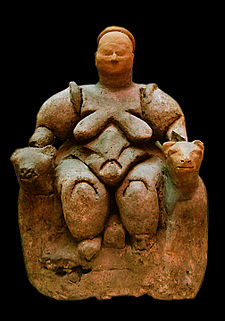 Seated Mother Goddess of Çatal Hüyük
Seated Mother Goddess of Çatal Hüyük
c. 6000 B.C. |
The Fall 2004 Module, "History of the Portrait,"
focused on the evolution of art, beginning from ancient drawings
of animals, and sometimes humans, on cave walls, to figurine
sculptures such as "fertility figures," and on to
artwork during the Egyptian, Greek, and Roman eras, eventually
leading to the more sophisticated portraiture of the Northern
and Southern European Renaissance. I found the concept of human
figurines to be very interesting because I did not expect figurines
of the Paleolithic, Mesolithic, and Neolithic Eras to be ancestors
of the Renaissance-era work of da Vinci, or Velasquez, or the
predecessors of modern paintings from artists such as Picasso
or Dali. The human figurines discussed in class were primarily
"fertility figures" – figures paying homage to the
fertility of the female and the virility of the male in the
act of procreation -- originating from European, or "Western"
cultures such as Mesopotamia, closer to the waters of the Mediterranean.
Professor Bromley mentioned in class that Eastern European art
of the Paleolithic through the Neolithic Eras focused more on
this type of sculpture compared to portraiture. However, the
use of human figurines is not exclusive to Western art; it extends
to the art of Eastern Asian cultures as well. Human figures
of the ancient Indus Valley Civilization in present-day Pakistan
and India of South Asia exemplify the common use of human figurines
as fertility figures, and also illustrate the roles of children,
women, and men of Indus Valley culture. The Indus human figurines
are somewhat similar in their purpose in society, but are differentiated
from their Western counterparts in the figurines’ ornamental
features.
|
| During the Paleolithic and much of the Neolithic
Eras, mankind was primarily living as a hunter-gatherer lifestyle,
first using stones as tools. Humans needed to hunt animals for
their sustenance; communal bonds between hunters and their families
may have developed, but the need to settle permanently on the
land was not justified. However, by the end of the Neolithic Era,
a few civilizations such as Egypt and Mesopotamia in the West/Middle
East, and the Indus Valley and China in the East, began to develop
as people began to depend on each other for physical, psychological,
and cultural means. Of these ancient civilizations, perhaps it
is the Indus Valley Civilization that is most easily overlooked
by modern researchers. Nevertheless, the Indus Valley Civilization
was one of the most advanced settlements of its day. Situated
along the banks of the Indus River moving inland from the Arabian
Sea, the Indus Valley Civilization is thought to have extended
for about 700 years, from around 2600 to 1900 BC. The Indus Valley
Civilization was only brought to an end by a combination of attacks
by Aryan neighbors to the west and a decline caused by an overextension
of resources. The Indus Valley Civilization could be best described
as a complex network of at least 1500 towns and cities spread
over 680,000 sq. kilometers of land. The inhabitants of the Indus
Valley are believed to have been dark-skinned, or Dravidian, most
likely ancestors of the darker-skinned peoples of South India.
A few of the most well-known Indus cities include Mohenjo-Daro
and Harappa. All cities were designed according to a master plan,
and featured organized housing for the rulers, well-to-do, and
the commoners. Most cities were constructed out of brick and featured
communal areas such as "Great Baths," likely used for
cultural/spiritual purposes. Cities were also advanced – in Mohenjo
Daro, every house had a private well dug deep to provide water,
along with public wells located outside for the general public
and travelers. All cities also had an organized system to safely
transport sewage waste away, and most houses had private bathing
areas and latrines. While the language(s) of the Indus Valley
have not yet been deciphered, evidence of written documents and
inscriptions prove the presence of sophisticated communication
in the Indus society. Art and cultural development was also important
to the dwellers of the Indus Valley Civilization. The importance
of art can be seen on ornamented seals belonging to rulers, to
terra-cotta disposable drinking cups. |
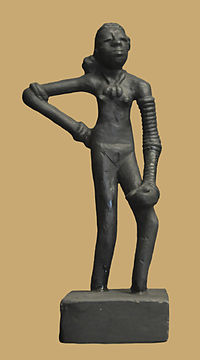 Dancing Girl of Mohenjo-daro
Dancing Girl of Mohenjo-daro
c. 2500 B.C. |
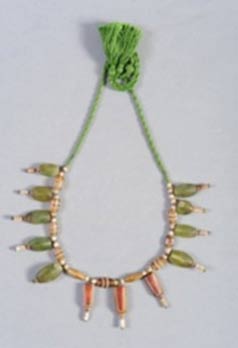 Beaded necklace of the Indus Valley
Beaded necklace of the Indus Valley
c. 2,600 – 1,900 B.C. |
|
Jewelry was highly ornamented, and every man and
woman wore at least one piece of jewelry. A few types of jewelry
such as necklaces and bangles show direct lineage to the more
ornamented necklaces and bangles of modern Indian jewelry. |
|
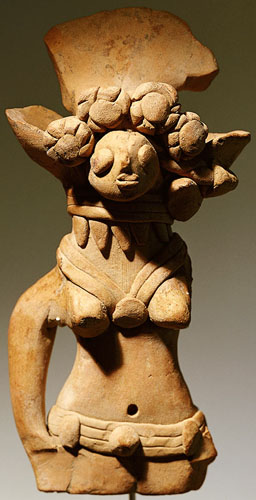
Terra-cotta figure with a headdress of
flowers
c. 3000 B.C.
|
Human figurines were also found in the Indus Valley.
Like other civilizations such as Mesopotamia which featured human
figurines, the use of these figurines was to primarily celebrate
childbirth and fertility in the female and virility for the male.
It is presumed that the human figurines may have been involved
in a cultural or ceremonial event. However, one reason why human
figurines are often hard to find intact or in good condition in
the Indus Valley is that the figurines were often given as toys
to children after their ceremonial use and then likely discarded.
This is in sharp contrast to Mesopotamia, where human figurines
were often involved in the burial process. In addition, the figurines
at the Indus Valley excavation sites were found to be primarily
made out of the medium terra-cotta. |
| Figurines of children are a common find among the
Indus figurines. Children were highly revered as they were the
products of the successful act of procreation and childbirth.
Due to complications in pregnancy, the mortality rate for women
and children during childbirth was relatively high. Many children
figurines are actually children nursing at the breasts of their
mother. The position of the figurine is usually a nursing infant
situated on the left hip, while leaving the mother’s right arm
free to perform other tasks. This anatomical position is similar
to the characteristic pose of Indian village women, nursing their
young, today. Like other civilizations of the time, the children
are depicted to be primarily male, perhaps showing a gender bias.
However, the children figurines of the Indus Valley are markedly
different than their counterparts in the West in their ornamentation.
Children figurines of the Indus are usually shown nude, but their
ornamentation often includes a necklace and a turban (males).
This is culturally significant because both genders wore necklaces
and the turban is a hairdressing still worn today by many Indian
men. Other figurines of children include their toys as well. One
common toy many children figurines have in their hand or are associated,
is a small disc. These small discs are part of a game called "pittu."
In this game, still played today in North India and Pakistan,
a group of children stack up their discs and attempt to knock
all of the discs down by throwing a ball. Other games include
terra-cotta spinning tops and miniature objects such as musical
instruments and cooking pans, meant to prepare children for an
adult life. |
|
|
|
"Figurines of women are perhaps the most
plentiful of the figurines in Indus Valley. The reason for this
is unknown, but it proposed that women were given a special place
culturally in society, due to their ability to produce offspring.
Indeed, studies of burial sites at Mohenjo-Daro and Harappa have
shown that a man was often buried with his wife’s family. The
female figurines are easily distinguished by a curving, pear-shaped
body with large protruding breasts. The effect of these female
figurines is two-fold: it emphasizes the beauty, and phallic/
sexual nature of the female; but at the same time, cherishes the
nurturing, motherly nature of the female. The figurines of the
women tend to also be heavily ornamented. It is, therefore, easier
to learn about the culture of the Indus Valley through these female
figurines." (encarta.msn.com)
The head region of the figurines usually show a complex arrangement
of hair and flowers and usually head ornaments, therefore showing
a greater cultural interest in hair style, likely related to a
particular ethnic community or family within the civilization.
On many figurines seen today, parts of the headdresses have broken
off. Clothing on women figurines include short skirts. Additional
ornaments on the female figurines include belts, necklaces, and
bangles. While males also wore these accessories, the female figurines
demonstrate that the women most likely wore larger, more prominent
necklaces, and a variety of many bangles on their arm. In reality,
this jewelry was gold, bronze, agate, ivory, and semiprecious
stones. However, in the figurines, they are simply outlined and
sculpted onto the surface. Almost all figurines were crafted from
terra-cotta, but a few sculptures towards the end of the Indus
Valley Civilization have been cast of bronze. Modern bronze sculptures,
especially prominent in Hindu India, seem to have originated from
the human figurines of the Indus Valley. |
|
Figurines of men are slightly harder to find in the Indus Valley
excavations compared to those of females. Figurines of men tend
to be more simplistic, and little can be told of their clothing
or accessories they may have worn. This is because most male
figurines are shown in the nude. The reason for this is not
known, but could be because of the ceremonial purposes of the
male figurine related to strength and virility. Because the
male figurines were not considered to be as beautiful as the
female figurines, many male figurines studied today are broken
in half or have substantial parts missing. Nevertheless, it
is possible to reconstruct the ornamental design of the male
figurines and draw parallels to the Indus Valley society. For
example, almost all male figurines have a turban, or similar
style of headdress. Some male figurines which are intact with
their arms may hold a spear, signaling strength and protection
of the Indus from outside attack. Many adult male figurines
have a projection on the chin for a beard, some closely combed,
others combed out, and spread wide. Male figurines tend to have
much less jewelry than the females; male jewelry in the Indus
Valley figurines typically includes one necklace or one bangle
on an arm. It is likely that the materials used to make these
ornaments for men were different than the materials and styles
used for the women, however it is difficult to make a distinction
in the figurines themselves. However, males in higher socio-economic
levels tended to have more ornaments; the famous "Priest-King"
sculpture (right) of Mohenjo-Daro shows multiple pieces
of jewelry, such as a bangle and a headband.
The human figurines of the Indus Valley Civilization reflect
the common use of figurines in all cultures during this time
period, to celebrate the act of procreation and childbirth.
While celebrating fertility and virility may seem arcane in
a modern context, producing children successfully was a crucial
yet dangerous task for all members of society, in order to ensure
survival of the family unit, civilization, and their culture.
However, the human figurines of the Indus Valley Civilization
are unique in that their figurines are more than objects celebrating
procreation – the figurines also include details of the clothing,
jewelry, hair styles, and toys that were integral to the Indus
Valley Civilization. While much of the puzzles surrounding life
in ancient Egypt, Mesopotamia, and China have been solved by
extensive research, excavation, and a deciphering of their languages,
modern society is only now beginning to unlock the stories behind
one of the oldest civilizations of the world - the Indus Valley
Civilization. Because the ancient languages of the Indus have
not been deciphered yet, by studying the significance of these
human figurines and other pieces of art, researchers can better
understand the civilization that is arguably the birthplace
of all modern cultures of the Indian subcontinent.
|
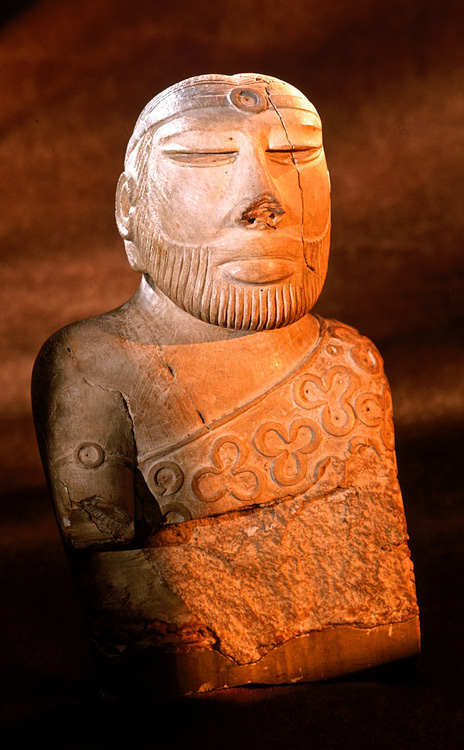 2200-1900 B.C.
2200-1900 B.C. |
References
"Indus
Valley Civilization." Microsoft Encarta Encyclopedia Online.
Internet. Online ed. 2004. <http://encarta.msn.com/encyclopedia_761556839/Indus_Valley_Civilization.html>
Urmila, Sant.
Terracotta Art of Rajasthan (From Pre-Harappan and Harappan Times
to the Gupta Period). New Delhi, India: Aryan Books International,
1997.
Pulsipher, Lydia
Mihelic, and Alex Pulsipher. World Regional Geography. 2nd
ed. New York: W. H. Freeman and Company, 2003.
Kenoyer, Jonathan
Mark. Ancient Cities of the Indus Valley Civilization. New
York: Oxford University Press, 1998.
Bromley, David J. 17 Dec
2004. History of Portraiture - VCU Honors. 01 Nov 2004. <http://www.artviews.net>.
next
| contents 2004 | home
|




